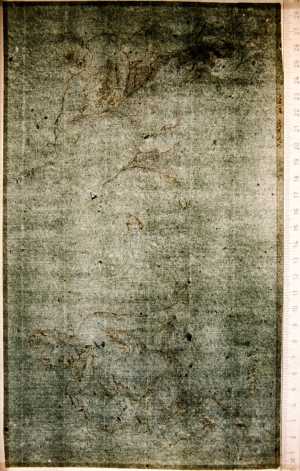Specifications
| Title | Two Seated Female Fauns with Children |
|---|---|
| Material and technique | Pen and brown ink, grey wash, on blue paper |
| Object type |
Drawing
> Two-dimensional object
> Art object
|
| Location | This object is in storage |
| Dimensions |
Height 172 mm Width 288 mm |
|---|---|
| Artists |
Artist:
Anoniem
Previously attributed: Grechetto (Giovanni Benedetto Castiglione) Previously attributed: Paolo Veronese (Paolo Caliari) |
| Accession number | I 47 (PK) |
| Credits | Loan Stichting Museum Boijmans Van Beuningen (former Koenigs collection), 1940 |
| Department | Drawings & Prints |
| Acquisition date | 1940 |
| Creation date | in circa 1550-1600 |
| Signature | none |
| Watermark | Walking Angel in a vertical oval surmounted by a six-pointed star (69 x 39 mm, top centre, to the right, on P5 of 7P, vV, trimmed folio), similar to Briquet 645-657 but without countermark (Vicenza, Ferrara, Salo, 1535-84) [zie image] and to Piccard Online AT3800-PO-21412 (Trento 1568) |
| Inscriptions | 'Benedetto Caliari' (below right, pen and brown ink, '167' (verso, centre, pen and brown ink) |
| Collector | Collector / Franz Koenigs |
| Mark | Z. Sagredo (L.2103a), inv. B.C.No:12, F.W. Koenigs (L.1023a deest) |
| Provenance | Zaccaria Sagredo (1653-1729, L.2103a, inv. 'B.C.No.12'), Venice; - ; Franz W. Koenigs (1881-1941, L.1023a deest), Haarlem, acquired in 1927 (Benedetto Caliari); D.G. van Beuningen (1877-1955), Rotterdam, acquired with the Koenigs Collection in 1940 and donated to Stichting Museum Boijmans Van Beuningen |
| Exhibitions | Rotterdam 2010 (coll 2 kw 7) |
| Internal exhibitions |
De Collectie Twee - wissel VII, Prenten & Tekeningen (2010) |
| Research |
Show research Italian Drawings 1400-1600 |
| Literature | Tietze/Tietze-Conrat 1944, no. 2194 (not Benedetto Caliari, closer to Benedetto Castiglione); Tietze 1948, pp. 56-57, ill. (copy after) |
| Material | |
| Object | |
| Technique |
Washing
> Wash
> Drawing technique
> Technique
> Material and technique
Washing
> Wash
> Drawing technique
> Technique
> Material and technique
|
| Geographical origin | Italy > Southern Europe > Europe |
| Place of manufacture | Venice > Veneto region > Italy > Southern Europe > Europe |
Do you have corrections or additional information about this work? Please, send us a message


























